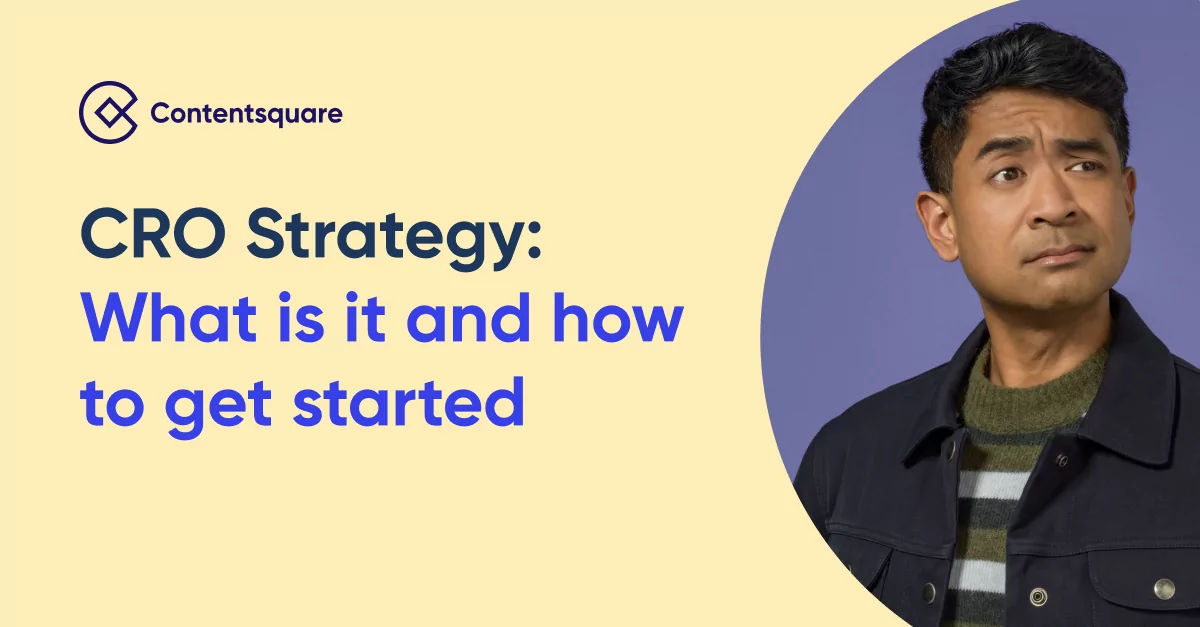
The B2B Conversion Playbook for Digital Teams
6 user-driven insights that go beyond lead generation

Until very recently, you could define conversion rate optimization (CRO) as the practice of increasing the percentage of users who perform a desired action on a website, such as buying a product or service, signing up for a newsletter, or simply clicking on certain links.
However, for leading CRO practitioners, this definition doesn’t cut it anymore. It’s too short-term and too tactical. As the saying goes, what got you here won’t get you there.
Becoming successful at CRO today means going beyond short-term, tactical thinking. To drive digital transformation in your organization and influence the C-suite you need to think strategically, not tactically.
But what does it mean to think strategically about CRO? What’s the difference between CRO strategy and tactics? Most importantly, what steps should you take to become a strategic CRO mastermind?
This ebook aims to define the mindset and goals of strategic CRO. To help you diagnose where you are now on that journey. And to give you the practical, actionable insights you need to become a successful strategic CRO practitioner.
A CRO strategy is a systematic approach utilized to improve the conversion rate of a website or digital platform. It involves analyzing visitor behavior, identifying areas that can be optimized, and implementing changes to increase the desired actions, such as purchases or sign-ups.

The B2B Conversion Playbook for Digital Teams
6 user-driven insights that go beyond lead generation
The main goal of a CRO strategy is to enhance the user experience and maximize the effectiveness of a website in generating conversions. This can be achieved through various tactics and techniques, including:
By implementing a well-defined CRO strategy, businesses can continuously enhance their digital presence, improve conversion rates, and ultimately drive revenue growth. It is an ongoing process that requires monitoring, testing, and iterating based on data-driven insights to ensure continuous optimization and success in the digital landscape.
While tactical CRO is important, strategic CRO helps to optimize ROI and lead digital transformation across your organization. Implementing a CRO strategy entails a mindset shift towards long-term rather than short-term thinking. You must gain a deeper understanding of your customers and align CRO goals with the broader goals of your business.
To diagnose where you are on your journey towards strategic CRO, work out where the gaps are. These could be in the skillset of your team, in your processes, or in the data points you currently have access to.
According to the industry experts we interviewed, there are 7 key steps you can take towards becoming a strategic CRO mastermind:
Defining a CRO strategy The first step in becoming a strategic CRO mastermind is to define what strategic CRO is.
Marketers and CRO practitioners are used to thinking tactically. They run multiple A/B tests across a range of variables and then try to draw conclusions from the results.
This tactical CRO mindset focuses on conversion percentages, averages, and benchmarks. But having such a data-led approach can lead to not focusing enough on long-term goals. It can also lead to a lack of joined-up thinking.
A strategic CRO mindset instead starts with the bigger picture. On the one hand, that means trying to gain a deeper understanding of your customers and prospects. On the other, it means looking at where CRO fits into the broader CRO strategy goals of the business.
CRO strategy is about defining long-term goals, and then working out what data points you need to help reach those goals. Then focusing on the KPIs and tactics that will get you closer to those goals.
Moving from short-term goals to a long-term vision means shifting focus. Rather than focus purely on front-end tests—for example optimizing landing page conversion—strategic CRO defines the long-term goals and then works backward.
To get a long-term view you need to:
Tactical CRO might aim to maximize conversions to a sale. Strategic CRO aims to attract and convert customers who are more likely to spend more money with you. These customers buy more of your products or services and stay with you longer.
As another example, tactical CRO might aim to maximize click-throughs from a specific page. Strategic CRO looks at the entire customer journey and aims to optimize every stage of the customer experience.
Here are examples of the kinds of KPIs that help drive strategic CRO:
Annual recurring revenue (ARR): used to work out the annual value of a subscription or contract. Because ARR is the amount of revenue that a company expects to repeat, you can use it to predict future growth.
Customer lifetime value (CLV): the total value to your business of a customer over the whole period of their relationship with you.
Sales pipeline: a representation of your prospective customers/clients, what stage they are at in the sales process, and how much revenue you expect to earn from them.
Sales velocity: how quickly sales move through your pipeline and generate revenue, based on four metrics:
Domain authority: an SEO concept that describes the strength of a given web domain, and how findable it is on search engines. usually measured on a score out of 100 using specific digital tools.
Sentiment analysis: an analysis based on aggregated reviews or social media mentions, which indicates whether your audience feels positive, negative or neutral about your brand. There are a variety of digital tools that can do this for you.
To become a more strategic CRO practitioner, you need to work out where you are on your CRO strategy journey.
Every organization is different, and you’ll need to work out where you are in the context of the strategic priorities in your business. But there are some simple rules that everyone can adapt to suit their circumstances.
Here’s a handy set of questions you can use to diagnose where you are with your CRO, split into three parts:
CRO strategy optimization works best when you are clear about your strategic goals and can measure your progress towards those goals. Business priorities and external pressures change constantly. So you do need to revise your goals periodically, as well as update them in line with your progress. Once you reach your goals, it’s time to set new ones. CRO strategy is about establishing a process of continuous improvement.
Tactical CRO often falls into the trap of testing what you know you can measure. CRO strategy focuses on working out what you want to test and then finding the data you need to be able to carry out those tests. It’s important to understand where you may need more data, and then look into how you can get access to it.
Now you know where you are, it’s time to look at some practical steps you can take on the path to boost your CRO strategy. We reached out to leading CRO experts to get their insights. Here’s what they told us.
“You need to have a clear direction on where the company is heading, understand how this fits in with your customers and what your value proposition is, and then ensure that you choose strong metrics that help you to move in this direction across the whole company.” — Evie Brockwell, Senior Product Manager, Booking.com
“The most transformational thing we’ve employed with our clients is the use of OKRs—objectives and key results. They help provide focus, alignment and direction by their very nature. I’m a huge advocate for them and if you can align your optimization goals to what the wider business is trying to achieve, I think you’re on to a winning path.”— David Mannheim, Global VP Conversion Rate Optimization, Brainlabs
“Focusing on insights means prioritizing a test that might not drive a lot of impact in the short term but can help you learn a lot about your customers and drive new and future product or testing ideas.”—Thorsten Tekieli, Customer Success Lead EMEA Central, Contentsquare
“Understand what you’re trying to improve and why, as well as fundamentally how you’ll measure its success.” —Sam Counterman, Vice President of Brand & Growth Marketing
For Sam Counterman, “you’ll never achieve everything in one go, so you have to create a roadmap and test one thing at a time”.
According to Thorsten Tekieli, running small tests in series is the best way to prove a hypothesis and create support in your organization for larger budgets:
“Think about the smallest possible test you can run to prove a hypothesis. Quick and small experiments like this can help you drive excitement and unlock budget for a bigger test – or to pivot before sinking a lot of money.”
For David Mannheim, speed and focus are the keys to success. He employs an Agile methodology based on sprints, because “sprints give us the pace we need to rapidly identify, understand and execute solutions”.
Thorsten Tekieli suggests sharing results across your organization. This helps the company to see the value of CRO strategy. It also encourages them to suggest new hypotheses to test.
“Share your tests via email newsletters, in your Slack channels. Create small videos or executive summaries. People will start sharing ideas or challenging your hypothesis. Whatever the response, it will drive your program and the focus on your customers,” he says.
Successful CRO strategy calls for a mix of different tools that supply different data points. When combined these can give you a full picture of the activity on your site.
David Mannheim breaks the tools he uses down into three categories:
To implement your CRO strategy, the team needs a range of skills. For Evie Brockwell, every team needs to be able to:
According to David Mannheim: “Specialists working together to achieve an outcome is optimization. When you have a UX analyst, a UX designer, a UX researcher, an engineer all working on problems, the whole is greater than the sum of its parts.”
Sam Counterman notes a rising trend of “cross-functional CRO teams involving data scientists, web managers, paid media managers, etc.”
For Thorsten Tekieli, the key skillsets include:
The exact mix of data points will vary according to your CRO strategy priorities, your industry, and your target customers. But the recommendations of our experts provide a good starting point for thinking about which data would be most effective for your CRO strategy.
David Mannheim believes in using funnels and segmentation to identify and resolve any discrepancies. He recommends segmenting your funnel using the following order of priority:
“Continually diving deeper into segmented funnels and comparing them on attributes will help you understand your areas of concern,” he says.
For Evie Brockwell, the simple answer is to combine as many relevant qualitative and quantitative data sources as possible, including:
Sam Counterman agrees on the effectiveness of combining multiple data sources: “The Contentsquare platform (zoning specifically) gives us a real-time view of what is happening on the front end with CTRs and exposure times, whereas Salesforce will give us the performance-based view informing us of pipeline and ROI. Bringing these data sets together in a single dashboard view lets us quickly understand the what, why, and how of what’s going on,” he says.
Thorsten Tekieli specifically recommends the click recurrence metric in Contentsquare because “it’s such an easy way to identify friction points in a specific zone”. “In combination with Quantify I can easily tell if that issue has an actual impact on conversion or how many visitors were impacted,” he adds.
How this restaurant drove $7.8 million annualized uplift in revenue through one A/B test:
The restaurant’s team noticed customers on their highly-visited ‘Our Deals’ page weren’t clicking on the deal cards, but they couldn’t understand why.
Using Contentsquare’s zoning analysis tool, they identified that customers were much quicker to click the “View Basket” CTA rather than the deal cards.
The team hypothesized that the lack of CTA on the deal cards themselves might be making them look unclickable to customers. So they decided to run a test to find out.
The restaurant’s digital team A/B tested adding a CTA to each of the deal cards.
In the variant, when a customer clicked on the deal card CTA, it opened up the deal builder experience where they could select their choice of pizza, toppings, and drinks, then add that to their basket. They ran the test for two weeks.
The variant (with the deal card CTA) was the clear winner. Extrapolating on the results seen, our customer anticipates an annualized uplift of $7.8 million in revenue.
“We use Contentsquare to discover opportunities where there’s friction, where there are pain points, where we can potentially improve the customer experience, and where we can see the customers are having a tricky time interacting with our website. We were able to see the ROI within three or four months of having onboarded the product,” says Global Head of Analytics.
Take a product tour Get to grips with Contentsquare fundamentals with this 6 minute product tour.
How New Look increased conversions by 19% with user-generated content
New Look’s test and target team were looking to experiment to increase the CRO strategy with User Generated Content (UGC). They knew UGC got high engagement on other areas of the site, so they wanted to see what would happen when it was placed on product pages.
During the test, they exposed users to UGC on both the PLP and the PDP, replacing the first image in the carousel in both instances.
The results
They saw a marked improvement in page performance. The number of users reaching a PDP increased by 23%, indicating the new images were driving users to click. And overall product conversion increased by 19% — proving the images were helping users to purchase, too.
Topline incremental uplift on revenue was +5.5% over a week. Faith estimated the potential revenue uplift when using UGC imagery on more products throughout the site was 98%.
“Contentsquare helped us look at the results in a much more visual way and also understand the customer journey as a whole.” says Faith Dallas, Test and Target Specialist at New Look.
The digital experience you offer on your website should be a source of competitive advantage. A strategic approach to CRO strategy helps ensure you offer the digital experience your customers want by helping you focus on their needs and frustrations.
But you need to be able to see the user behaviors and the barriers that are negatively impacting your customers once they’re on your site. For this, you need access to the right data.
With advanced digital intelligence tools, you can see:
Armed with these insights, you can then:
This level of deep insight fuels a CRO strategy approach. You can define your CRO strategy goals, set out your roadmap, and prioritize which hypotheses to test.
You can measure your progress effectively and prove the impact you’re having on your organization’s bottom line.
More importantly, you are able to understand your customers and adapt your digital experience to their expectations. You can adapt web pages to match your visitors’ drivers so they know where to find what they need when they land on your site. You can amplify the hooks that get your visitors to move through the customer journey by using elements they find persuasive. And you can minimize the frictions and barriers to action in your funnel.
This in turn helps you influence the C-suite, increase your budget, and drive the digital and CRO strategy of your company.